| dc.description.abstract | Malaria continues to kill over a million people each year, with more than 90% of these
casesfound in sub-Saharan Africa. In many populations affected by malaria, conventional drugs
areoften unaffordable or inaccessible, and increasing drug resistance by the malaria parasite, P.
falciparum, is of significant concern. The current study involved determination of antimalarial
activityand toxicity of selected plants from Msambweni district, Coast province; Kenya.
Aqueous and organic [Chloroform: Methanol (1:1)] extracts from each plant were
prepared and used to determine in vivo anti-malarial activity and toxicity. They were also
screened for their phytochemical constituents. To evaluate antimalarial activity, Swiss albino
mice (Mus musculus L.) were infected with Plasmodium berghei parasites through
intraperitoneal route. Crude extracts were administered orally everyday at the same hour for four
daysat a dosage of 100 mg/kg from Day 0 to Day 3. Thin blood smears were prepared on Day 4
from each mouse and stained with 10% Giemsa in phosphate bUffer, pH 7.2 and examined
microscopically for assessment of parasitaemia. The mean parasitaemia in each group of mice on
Day4 was used to calculate the percentage chemosuppression for each extract.
Toxicity of the crude extracts was evaluated using Brine shrimp larvae (Artemia salina L.
nauplii). ANOVA was used to analyze the means of the parasite growth inhibitions while LDso
was estimated using Finney's probit analysis program. The screened plants exhibited varying
degrees of chemosuppression. Aqueous extracts of Adansonia digitata L. (Bombacaceae),
Zanthoxylum chalybeum Engl. (Rutaceae), Launea comuta (Hocht. ex Olivo& Hem) C.Jeffrey
(Compositae) and Canthium glaucum Hiern. (Rubiaceae) had 60.47%, 44.93%, 38.13% and
31.98% parasite growth inhibition respectively. CHCb: MeOH extracts of Ciglaucum and
A.digitata showed parasite growth inhibition of 43.76% and 32.90% respectively. Chloroquine
(positivecontrol) had 87.23% parasite growth inhibition.
Crude extracts of A.digitata and Ciglaucum had LDso>1000 ug/ml and were considered
tobenon toxic to Brine shrimp larvae unlike crude extracts of Z.chalybeum and Lcomuta which
had LDso<500 ug/ml. Phytochemical screening of the crude extracts showed that alkaloids,
flavonoids, sesquiterpene lactones and saponins were present in Aidigitata, C.glaucum,
Lcornuta and Z.chalybeum.
This study reports for the first time the in vivo antimalarial activity of the crude root
(aqueous and organic) extracts of Cglaucum and crude leaf (aqueous and organic) extracts of
Lcornuta. In addition the toxicity of aqueous and organic root extracts of Cglaucum is also
beingreported for the first time. From the study A.digitata and C.glaucum have been shown to
possess promising antimalarial activity and were not toxic to the Brine shrimp larvae. These
results indicate that there is potential for isolation of" new- scaffolds agamst Plasmodium
falciparum from the aqueous extracts of the two plants. | en |

